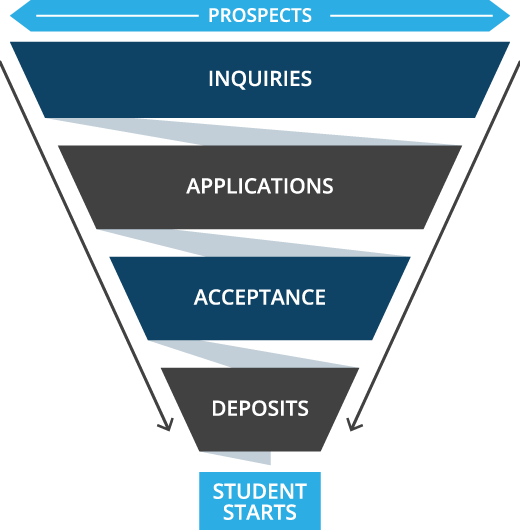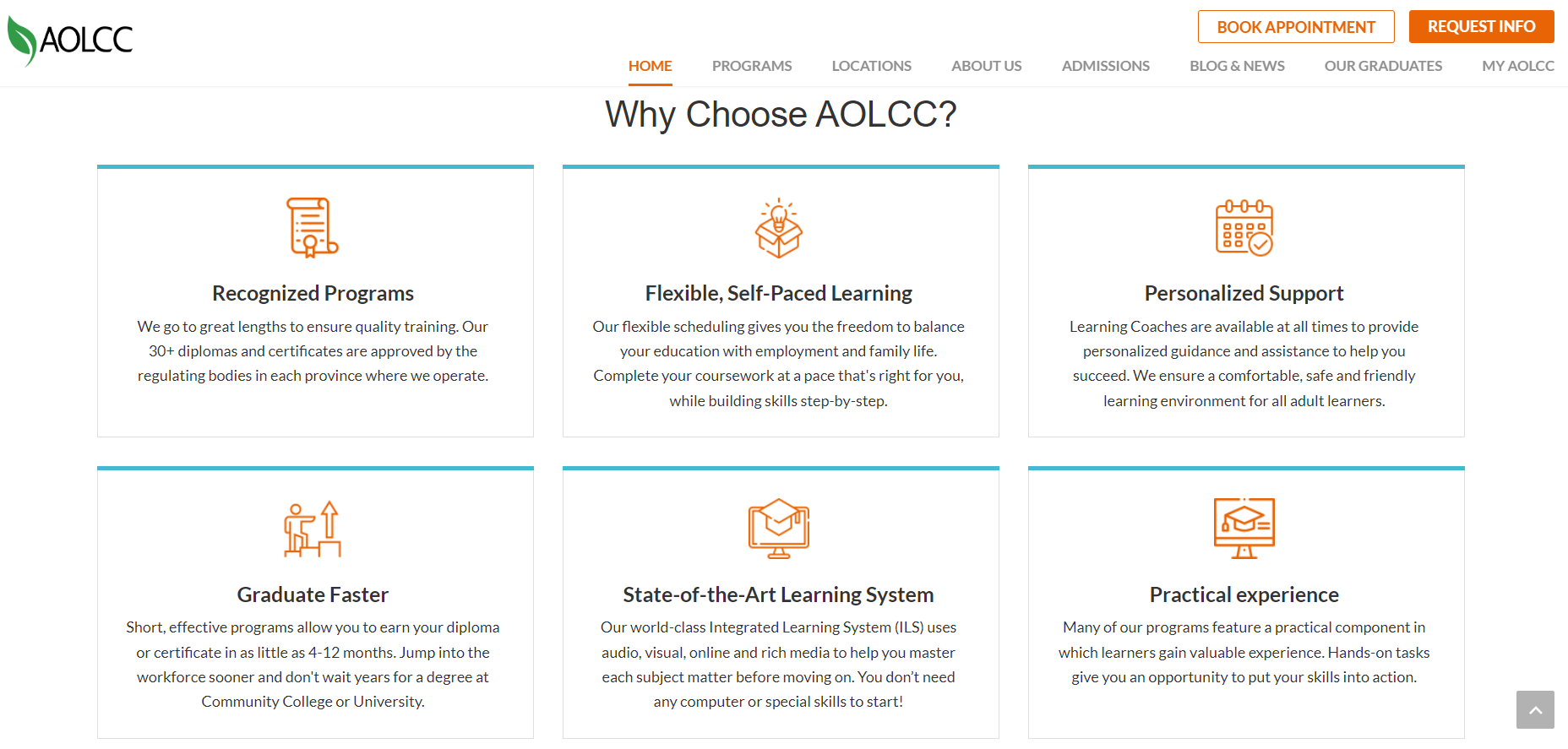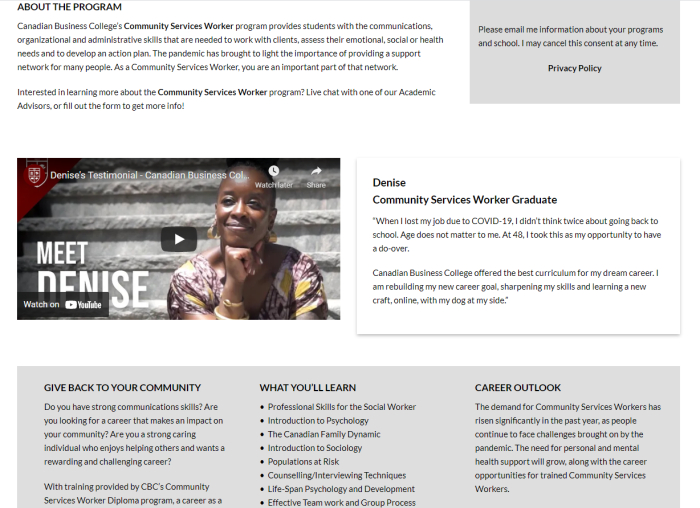A good digital marketing strategy gives a school a strong online presence, resulting in more prospects exploring its website and social media channels for a potential fit. Leveraging these efforts can result in better lead generation for colleges.
Here, you’ll want to ensure that the prospects you attract become more engaged—ultimately signing up for more interactions with your school and applying to become students.
Conversion rate optimization is the process of improving the conversion of prospects and current website visitors. When done right, it can significantly impact the number of inquiries and applications your school receives. This can increase your lead generation and convert more students.
To help you achieve this goal, we’ll explore key areas and steps for converting your website visitors. Here’s how your school can get started.
Pre-Audit Consultation for Schools
Could your school benefit from a digital marketing audit?

Taking a Closer Look at Your Admissions Recruitment Funnel Stages
Understanding your admissions recruitment or enrollment funnel is a good starting point for increasing your school’s conversion rate. This step requires data and observation, and you can start by noting how many inquiries, applications, and enrollments you receive.
You can take this further by calculating the conversion rate for each stage you outline in your enrollment funnel. If you want to be even more precise with your data, you can tailor the funnel to reflect your unique admissions process, adding new stages or creating more funnels to focus on different lead segments or programs.
Below is an example that outlines how leads move through the different student recruitment stages to reach enrollment:

At the top of the funnel, you’ll have prospects who have just visited your website or social media accounts. Typically, they’re in the awareness stage until they decide to engage more with your school.
This can be an email newsletter subscription, info session registration, a campus tour, or a personal call with your admissions team. After they provide their contact information to your school, prospects transition into leads, reaching the middle of your funnel.
Here, your school should aim to provide support and helpful resources to continue engaging your leads. The goal is to keep igniting their interest and push them closer to starting their student application.
Once they do, they move closer to the bottom of your enrollment funnel. This is where your school needs to motivate and encourage its leads to complete the application, eliminating any barriers or challenges in their way.
By analyzing how many prospects you attract and how many move onto the next stage in your funnel, you can determine where your team is succeeding and where you can put in more work to generate better results.
For instance, if your school is not generating enough leads at the top, then your next step is to boost your brand awareness (i.e. developing a stronger content strategy).
Alternatively, if you need to generate more leads in the middle or near the end of your funnel, you should be more focused on improving your outreach and engagement (i.e. email marketing).
The insights from your admissions recruitment funnel can help guide you toward creating a more impactful digital marketing strategy, giving you the push you need to optimize your digital presence.
Boosting Lead Generation for Colleges by Optimizing School Websites
Many prospects visit your school website to discover your program offerings and learn more about the student experience.
Lead generation for colleges allows you to showcase your strengths, generate new quality leads, and push your website visitors closer to converting.
By understanding their search intent and catering to their needs, your school can better engage leads and keep them wanting more.
Create Engaging Website Copy to Attract and Maintain Your Leads’ Interest
Keep a consistent brand voice that resonates and actively engages with your audience, capturing and maintaining their interest throughout their interactions on your site. Your website copy can highlight your USPs and showcase your school’s strengths.
Consider taking this opportunity to emphasize your competitive advantage and value proposition in an appealing and eye-catching way.
Your website’s copy can also encourage key actions. CTAs draw attention to the actions that direct prospects and lead to the desired destination on your site.
Example: AOLCC highlights the benefits prospects would gain by outlining its proposition value and emphasizing its unique selling points. The content expands on each point to captivate interested readers and keep them on the page longer.

An image of unique selling points listed by a college, improving student lead generation.
Source: AOLCC
Optimize Your Landing Pages and Forms to Increase Conversions
A landing page is different from your school’s homepage. The homepage acts as a base for all the key links on your website. However, a landing page is designed to maximize conversions—appealing to specific prospects instead of general website visitors. As a result, these landing pages typically generate more conversions than other pages on your website.
Landing pages are a key aspect of a school’s digital marketing strategy. Research shows they contribute a 4.5% conversion rate in the education industry—slightly higher than the average rate across all industries.
Because they play such a significant role in converting students, it becomes more important than ever to make sure your landing pages are well-optimized. Here are a couple of things to watch out for when optimizing your landing pages:
- Create a mobile-responsive landing page
- Increase your page speed
- Add eye-catching visuals to improve your web design
- Include a single CTA
- Create a clear and compelling copy (use bullet points)
- Add student testimonials or university rankings for credibility
Canadian Business College incorporates some of these key points on its program page.
The page content automatically resizes to fit the screen, and a hamburger menu is added to create a mobile responsive page.

This mobile-optimized website can facilitate higher education lead generation.
The page also includes engaging copy, which resonates with visitors’ interests and motivations and naturally guides them to scroll further. A student testimonial and an organized list of bullet points introduce what students can expect from the program.

This image shows that student testimonials can help colleges boost education lead generation.
It should be emphasized that the forms on these pages are essential, increasing lead generation for higher education. You’ll want these forms to be short, simple, and painless. This means only asking for the information you need.
It’s a good idea to include a lot of white space and use the right number and type of form fields to create a positive user experience.
The form on Canadian Business School’s website is well-positioned, eye-catching, and easy to fill out, making it more likely for prospects to follow through and convert.

An example of forms on a college website, allowing lead generation for schools.
Source: Canadian Business College
Take Advantage of Chatbots and Pop-Ups to Boost Lead Generation for Colleges
According to HubSpot, 47% of marketers use bots. That’s likely because chatbots provide a great service, giving your prospects the support they need whenever they need it. Interestingly, Ivy.ai’s research shows that 57% of students willingly share personal data with their school to receive individualized support, giving it great potential as a higher education lead generation.
Did you know…
According to HubSpot, more than one in three marketing leaders cite conversion rates as a top KPI that they prioritize tracking.
Chatbots can help push the leads in the middle or bottom of the admissions recruitment funnel closer to enrollment, answering any questions they may have 24/7 and directing them to helpful resources for continued engagement. This way, any concerns can be quickly addressed, and any barriers can be removed more easily, streamlining the admissions process.
Example: Algonquin College uses a virtual assistant to help students and prospects with basic inquiries on its Students Support Services page. When the live chat option is unavailable, students or prospective students still have the opportunity to leave a message and receive helpful answers once someone becomes available. This method ensures they get the needed attention, pushing them to become qualified leads as they engage further with your school.

Lead generation for colleges can be encouraged with a live chat feature, as shown here.
Source: Algonquin College
On another note, your school can optimize its conversion rate by integrating eye-catching pop-ups or banners with a “lead magnet.”
A Lead magnet is a free resource or downloadable item that prospects can access once they provide their email or contact information. In your school’s case, this can be a program curriculum, school viewbook, or career guide.
This method can be an effective way to quickly attract your prospect’s attention and motivate them to convert.
Example: Shillington appeals to its prospects by creating an “ultimate” career guide for those interested in pursuing graphic design.
The engaging copy, introducing the guide and confirming their email subscription, makes it even more compelling, prompting prospects to convert more readily.

Adding a lead magnet as shown here can be an effective approach to education marketing on a school website.
Source: Shillington Education
The key is to make sure these pop-ups and banners add significant value—offering your prospects valuable information and opportunities to make sharing their personal information worth it. Remember that you want to avoid creating distracting or annoying pop-ups and banners, making them easy to exit and move out of sight.
Using Marketing Automation to Build Stronger Relationships with Your Leads
Marketing automation, mainly automated email workflows, can be a great way for your school to build quick and meaningful relationships with its leads. Research shows that 95% of marketers who use generative AI for email creation rate it as “effective,” and 54% rate it as “very effective”.
By automating certain marketing activities, such as email newsletters or messages, your team can regularly follow up with interested prospects and provide the push they need to convert. This means sending them personalized content tailored to their needs and interests or providing additional resources and tips to motivate them to start an application.
Using CRM
With a strong CRM for education, your team can more easily manage working with a growing list of new contacts. By setting up effective automated email workflows, you can ensure that the right leads are being nurtured correctly, creating a positive impression that ultimately increases lead engagement and loyalty to your school.
The image below is an example of an email sent by Oxford College to engage its leads. Here, a compelling image immediately captures the viewer’s attention, and adding social media links makes it even more interactive. Engaging copy and an eye-catching CTA make this email more effective in driving results.

As shown here, CRM for education can be used to send prospects compelling email messages.
Source: Oxford College
Pro Tip: Quickly responding can show your prospects that you take their interest in your school very seriously. Setting up an email autoresponder can be a good way for your school to indicate that they’ve received the prospect’s inquiry and will follow up shortly.
You can use this space to provide relevant links to your website, including compelling CTAs to actions you want them to take. These actions will keep them engaged and help move them further along the enrollment journey.
Analyzing Lead Flow to Promote Better Lead Generation for Colleges
Lead flow describes the lead conversion path, focusing on how well leads move through the enrollment funnel. A good lead flow is well-structured and organized, allowing leads to pass from one stage to the other in an organized and seamless manner.
In this model, your admissions team can work efficiently with each new lead, guiding them along the conversion path without wasting valuable time or missing great opportunities.
Good lead flow can significantly boost lead generation for colleges, creating a supportive infrastructure for maximizing the potential that each lead brings in. As a result, improving your lead flow can be a way for your school to strengthen its lead generation and lead nurturing strategy.
You must analyze your enrollment process and understand how prospects interact with different team members to get these benefits. Here are some things you might want to consider during this process:
- How many leads are generated through your marketing activities? Does your admissions team share the same data as your digital marketers, or are there any discrepancies?
- How well is your admissions team following up with leads generated through marketing? Are they being nurtured effectively?
- Does your marketing and admissions teams have a shared understanding of a qualified lead?
Getting Started with Better Lead Scoring for Your School
A good way for your school to improve its lead flow is to create a lead scoring system. Lead scoring works by assigning a numerical value to your prospects’ qualities and actions to determine how interested and well-suited they would be for your school.
The scoring system is based on a scale 100—the higher the number, the higher the likelihood that these prospects convert.
It may sound counterintuitive at first, but this scoring system is subjective. This means that lead scoring can be different for each school. It all depends on what that school prioritizes most, with the focus on the school’s admissions criteria, preferences, and needs.
With a proper lead scoring system, you can better identify high-value leads that would be more likely to convert, given the right encouragement. Doing so would enable your school to direct its efforts and resources to where they need to go.
This can increase your team’s productivity, boost lead generation for colleges, and facilitate enrollment forecasting—giving you the insights you need to anticipate future student recruitment numbers better and plan for success.
Assigning Values and Optimizing Your School’s Lead Scoring Process
A CRM designed for educational institutions, such as HEM’s Mautic CRM platform, can help schools better tackle the lead scoring process. With a robust CRM, your school can set up a lead scoring model that automatically scores each lead depending on their actions and behaviours.
This model can be based on different types of data that you collect about your leads, including their demographic information, online behaviour, and social or email engagement.
Example: Below is a snapshot of how a lead score appears on HEM’s customized Mautic CRM platform. Here, you can quickly view the score at the top and review details that can help you determine the potential of this lead.

An image of lead scoring to illustrate impactful lead generation for higher education.
Consider the basic criteria for your programs and attribute a higher value to the leads that meet those requirements. Adding negative numbers may also help refine your results.
For instance, leads who do not open emails or interact with your admissions team can be given negative attributes that decrease their final score. This indicates to your team that these leads are less likely to engage with your efforts.
The numbers assigned to each lead will not necessarily add up to 100. They only give you an overview, or a general scale, of how compatible your existing leads are with your school and its programs.
To help you gather more data, you can contact your student recruiters for insights on factors influencing enrollment.
Similarly, you can survey your students or review your data analytics.
Analyzing your attribution reports on Google Analytics or checking which channels bring in more leads can help you develop a bigger picture of what works with your leads and what doesn’t.
With this information, your admissions team can pursue the right leads and avoid wasting time, effort, and resources on those who likely won’t convert.
Top Takeaways to Help You Convert More Students
Optimizing college lead generation typically starts with examining your existing infrastructure and data.
When you understand your enrollment funnel and lead flow then you can make more impactful changes that boost conversions and improve your school’s overall student recruitment efforts.
According to HubSpot, lead generation is the third most important metric used to measure the effectiveness of content marketing strategies. Seventy percent of marketers rate their leads as “high quality.”
You’ll want to take active steps to optimize your school website and lead flow.
This means optimizing for mobile, creating compelling web copy, designing strong landing pages with painless forms, and incorporating strategies that help you quickly address your prospects’ queries or capture their attention.
Regarding lead flow, it’s a good idea to analyze your leads and develop a lead-scoring system.
Once you’ve completed that step, then you’ll be in a better position to identify qualified leads and redirect your efforts and resources to where they need to be most, significantly improving your lead generation strategy.
Pre-Audit Consultation for Schools
Could your school benefit from a digital marketing audit?

FAQs To Consider:
What is the best way to recruit college students?
Understanding your admissions recruitment or enrollment funnel is a good starting point for increasing your school’s conversion rate. This step requires data and observation, and you can start by noting how many inquiries, applications, and enrollments you receive.
What is lead generation in recruitment?
Many prospects visit your school website to discover your program offerings and learn more about the student experience. Lead generation for colleges allows you to showcase your strengths, generate new quality leads, and push your website visitors closer to converting.






